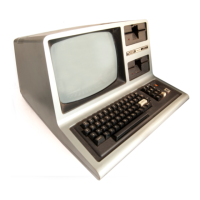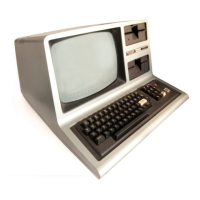57
02 is used as the write data pulse on nominal
(EARLY = 0 LATE = 0). 01 is used for the early, and
03 is used for the late. The leading edge of 04 resets
the STB line in anticipation of the next write data
pulse. When TG43 = 0 or DDEN* = 1,
precompensation is disabled and any transitions on
the WDIN line will appear on the WDOUT line.
When VFOE*/WF and WG are low, the Clock
Recovery circuits are enabled. When the RDD* line
goes low, the PU or PD* signals will become active. If
the RDD* has made its transition in the beginning of
the RCLK window, PU will go from a high impedence
state to a logic one, requesting an increase in VCO
frequency. If the RDD* line has made it transition at
the end of the RCLK window, PU will remain in the
high impedence state while PD* will go to a logic
zero, requesting a decrease in the VCO frequency.
When the leading edge of RDD* occurs in the center
of the RCLK window, both PU and PD* will remain in
the high impedence state, indicating that no
adjustment of the VCO frequency is required. By
tying PU and PD* together, an adjustment signal is
created which will be forced low for a decrease in
VCO frequency and forced high for an increase in
VCO frequency. To speed up rise times and stabilize
the output voltage, a resistor divider using R7, R10,
and R9 is used to adjust the tri-state level at
approximately 1.4V. This adjustment results in a
worst case voltage swing of plus or minus 1V, which
is acceptable for the frequency control input of the
VCO (U14). This signal derived from the combination
of PU and PD* will eventually correct the VCO input
to exactly the same frequency multiple as the FDD*
signal. The leading edge of the RDD* signal will then
occur in the exact center of the RCLK window, an
ideal condition for the 1793 internal recovery circuits.
4.1.10 Floppy Disk Controller Chip
The 1793 is an MOS LSI device which performs the
functions of a floppy disk formatter/controller in a
single chip implementation. The 1793 is functionally
identical to the 1791 used on the Model II FDC
Printer Interface Board, except that the data bus is
true as opposed to inverted. Refer to the appendix
section for more information on the FD1793. The
Model II Technical Reference Manual also contains a
good presentation of the 1791 FDC chip as well as a
discussion on Write Precompensation. The following
port addresses are assigned to the internal registers
of the 1793 FDC chip.
PORT# FUNCTION
F0H Command/Status Register
F1H Track Register
F2H Sector Register
F3H Data Register
Table 4.2 Port Allocation
4.1.11 Adjustments and Jumper Options
The Data Separator must be adjusted with the 1793
in an idle condition (no command currently in
operation). Adjust R7 potentiometer for a 1.4V level
on pin 2 of U14. Then adjust R6 potentiometer to
yield a 2MHz square wave at pin l6 of U11.
The Write Precompensation must be adjusted while
executing a continuous write command on a track
greater than twenty-one. Adjust R5 potentiometer to
yield 200nsec wide pulses at pin 4 of U11. This
results in a write precompensation value of 200nsec.
There are four jumper options on the Floppy Disk
Controller Board. They are designated on the PC
Board silkscreen and are referenced on the
Schematic Diagram. The jumpers should be installed
as described below.
JUMPER CONNECTIONS
A to B
E to G
L to M
H to J

